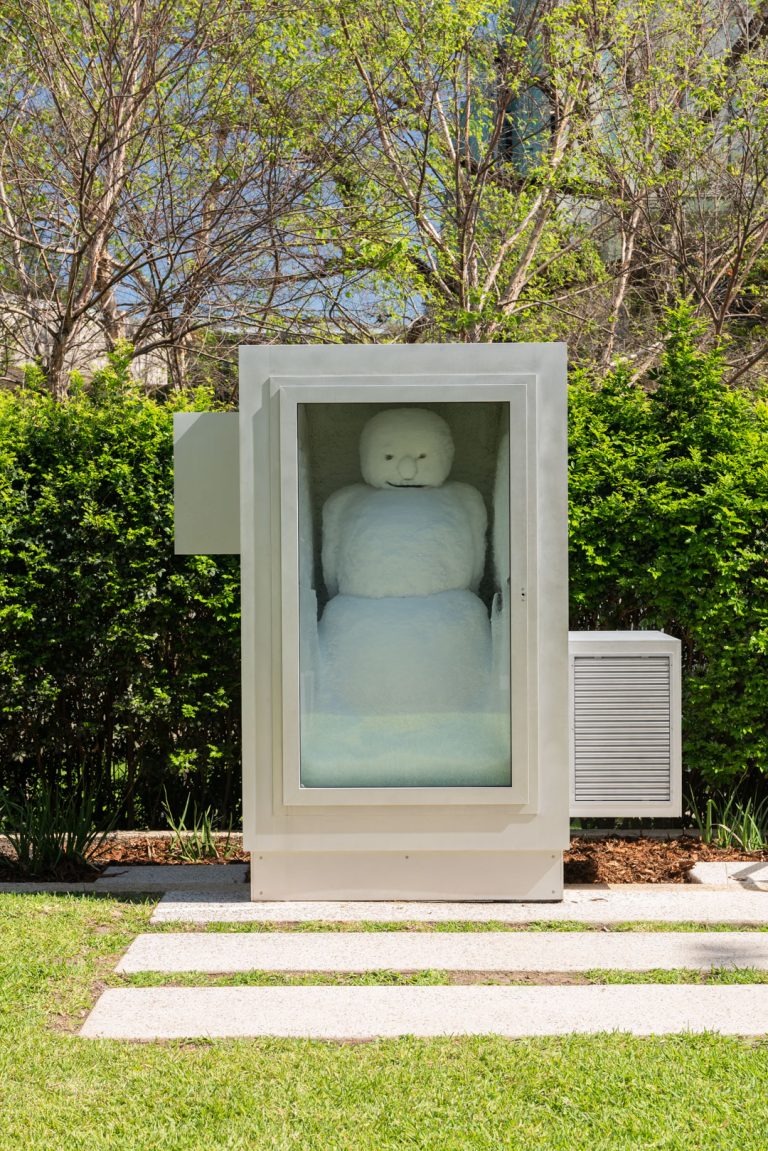We acknowledge the Traditional Owners of the land on which the Queensland Art Gallery | Gallery of Modern Art stands and recognise the creative contribution First Australians make to the art and culture of this country.

Peter Fischli / Switzerland b.1952 / David Weiss / Switzerland 1946–2012 / Snowman 1987/2017–2019 / Ice sculpture inside a vitrine, ed. of 2 with 2 AP, AP 2/2 / Vitrine: 218 x 209 x 142cm; Snowman: 130 x 70cm (diam.) / Purchased 2019 with funds from Tim Fairfax AC through the Queensland Art Gallery | Gallery of Modern Art Foundation / Collection: Queensland Art Gallery | Gallery of Modern Art / © Peter Fischli and Estate of David Weiss
Peter Fischli and David WeissSnowman 1987–2019
On Display: QAG, Sculpture Courtyard
In 1987, Peter Fischli and David Weiss (1946–2012) conceived of an artificial snowman that would remain frozen all year round. The sculpture was originally designed to stand outside the Römerbrücke thermal power station in Saarbrücken, Germany. Paradoxically, the power (and heat) produced by the factory would keep the snowman perpetually frozen.1
In 2017, Peter Fischli was commissioned by the San Francisco Museum of Modern Art to remake the work. The twenty-first-century Snowman is constructed from three copper spheres contained within a large freezer. As the frost gradually accumulates on the spheres, the snowman grows in size until he needs to be defrosted, shrinking down once more. His smile must be redrawn each day so that his expression does not fade amongst the layers of ice.
The work presents a contradiction: Snowman stays cold through electrical consumption, ultimately contributing to carbon emissions and global warming. While a melting snowman could be seen as a metaphor for global warming, it is heat that keeps Fischli and Weiss’s frosty Snowman alive.
Endnotes:
1 Beat Wyss, ‘Melting beauty’ in Fischli & Weiss: Flowers & Questions. Tate Publishing, London, 2006, p.181.
Peter Fischli and David Weiss began collaborating in 1979 with the so-called Wurstserie (Sausage Series) — a photographic series of sausages arranged as toys or characters in a play — which would set the tone for their future work. Seeking to investigate the artistic potential of mundane objects and situations, they manipulated everyday items into something new, unexpected, and often humorous.
Working across a variety of media, including sculpture, video and photography, they collapsed the distinction between high art and low art in much the same vein as Marcel Duchamp (1887–1968) or Dieter Roth (1930–98). Their playful practice encourages viewers to see the world anew, as if they were children once again.
Discussion Questions
1. Does a snowman seem out of place in Brisbane? What do you think Snowman’s home looks like?
2. What makes Snowman art? How have Fischli and Weiss transformed this everyday creation into contemporary art?
3. Discuss the contradictions present in the work. What do you think the artists’ intended meaning is?
Activities
1. Imagine the inside of Snowman. Design the inner workings of the sculpture, thinking about how you would care for it.
2. Plan a still-life arrangement using small, everyday objects frozen into a block of ice. Sculpt your block using heat or water, and then photograph your arrangement. Try experimenting with lighting to achieve different effects.
3. Working in pairs, create your own version of a snowman that represents where you live, using natural materials. Justify why you choose specific materials and accessories for your snowman.